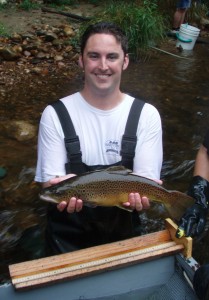Doctoral Candidate
Contact Info:
Email: Justin.Davis@ct.gov
Office phone number: 860-424-4181
Address:
Justin Davis
Fisheries Biologist
Connecticut Department of Energy and Environmental Protection
Inland Fisheries Division
Eastern District Headquarters
209 Hebron Road, Marlborough CT 06447
I am a life-long Connecticut resident who spent much of his childhood exploring streams, ponds, and coastal estuaries trying to capture anything that swam or crawled and put it in a bucket; little did I know then that I could someday make a career out of doing essentially the same thing. That realization dawned on me as a teenager, when I participated the Summer Marine Studies Program at Project Oceanology in Groton CT for four summers, during which I conducted several small-scale research projects on nearshore fish and invertebrate communities in Long Island Sound. Immediately, I was “hooked”, and there was no doubt about the profession I was going to pursue.
I received my B.S. in Marine and Freshwater Biology from the University of New Hampshire in 1999, and then earned an M.S. in Natural Resources Management from the University of Connecticut in 2004. For my M.S. research, I conducted a demographic study of the Alewife run at Bride Brook in East Lyme, CT. Many populations of Alewives and closely-related Blueback Herring (commonly referred to in aggregate as “river herring”) have been reduced to critically low abundances in recent decades. By comparing the results of my study to one conducted on the same population in the 1960s, I discovered that the demography and life history of the Bride Brook Alewife run had changed significantly. Size and age structures were truncated – larger and older fish that had been common in the 1960s were largely absent. In addition, Alewives were maturing at younger ages and smaller sizes, and were less likely to survive to spawn multiple times in their lifetime. These patterns are now recognized as pervasive in river herring runs range-wide, and have motivated further research into the potential impacts of predation and oceanic bycatch.
I am currently a PhD Candidate in the Department of Ecology and Evolutionary Biology at the University of Connecticut. My PhD research is a natural outgrowth of my M.S. research: I am investigating the impacts of Striped Bass predation on river herring in the Connecticut River. The Connecticut River Blueback Herring run is an oft-cited exemplar of the river herring crisis, as annual passage of Blueback Herring at the Holyoke Dam fishlift has declined four orders of magnitude since the 1980s. Striped Bass, a known predator on river herring, have concurrently become abundant in the Connecticut River. There is strong correlative evidence that Striped Bass are a primary factor in herring declines, but there has been only limited study of either species in the Connecticut River. My study will assess the distribution, abundance, and demography of both species in the “lower” (below Holyoke) Connecticut River during the spring migration season, quantify Striped Bass predation rates, and model the potential to mitigate predatory impacts by altering management of the in-river recreational fishery for Striped Bass.
In 2007, I realized a long-term goal by accepting a position as a Fisheries Biologist with the Inland Fisheries Division of the Connecticut Department of Energy and Environmental Protection (DEEP IFD). At DEEP IFD, I work on a wide variety of freshwater fisheries management programs, with particular emphasis on Largemouth Bass, Walleye, Northern Pike, and Channel Catfish fisheries. I also oversee the IFD lake and pond angler survey program. My job is a mix of field work, lab work, and office duties. I feel very fortunate to have a job in which, on some days, I’m doing just what I’ve always loved to do: splashing around in the water and chasing fish.
View Justin’s CV here
